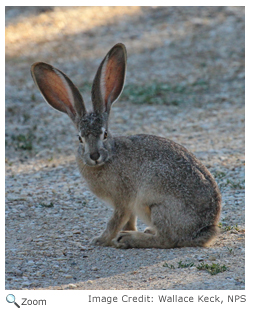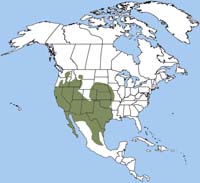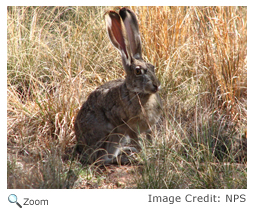Description
 The black-tailed jackrabbit has long ears with black tips and very long front and rear legs. It is about 18-24 inches in length and weighs four to eight pounds. It has peppery brown fur and a black stripe that runs down its back. The black-tailed jackrabbit has long ears with black tips and very long front and rear legs. It is about 18-24 inches in length and weighs four to eight pounds. It has peppery brown fur and a black stripe that runs down its back.
The black-tailed jackrabbit is not really a rabbit; it is a hare because its young are born with fur and with their eyes open. Males and females look alike, but females are usually larger.
Range  The black-tailed jackrabbit is found in the western United States from Washington south to California and east to Nebraska and Texas. It is an introduced species in Kentucky and New Jersey. The black-tailed jackrabbit is found in the western United States from Washington south to California and east to Nebraska and Texas. It is an introduced species in Kentucky and New Jersey.
Habitat
The black-tailed jackrabbit lives in meadows, prairies, desert scrubland, and farmland.
Diet  The black-tailed jackrabbit rests during the day and feeds in the late afternoon and the night. In the summer, it eats a variety of green plants. A favorite food is alfalfa. In the winter, it eats dried and woody plants. The black-tailed jackrabbit gets most of the water it needs from the plants it eats. The black-tailed jackrabbit rests during the day and feeds in the late afternoon and the night. In the summer, it eats a variety of green plants. A favorite food is alfalfa. In the winter, it eats dried and woody plants. The black-tailed jackrabbit gets most of the water it needs from the plants it eats.
| |
Life Cycle
 The black-tailed jackrabbit mates year-round. Males and females leap after and chase each other during mating season. The female black-tailed jackrabbit has as many as four litters a year. The young are born in a fur-lined depression. Most litters have between three to four young. The female moves the babies to separate locations to make them less vulnerable to predators. The babies only nurse for three to four days and are independent by the time they are a month old. The black-tailed jackrabbit mates year-round. Males and females leap after and chase each other during mating season. The female black-tailed jackrabbit has as many as four litters a year. The young are born in a fur-lined depression. Most litters have between three to four young. The female moves the babies to separate locations to make them less vulnerable to predators. The babies only nurse for three to four days and are independent by the time they are a month old.
Behavior  The black-tailed jackrabbit runs at speeds of up to 30 miles an hour and it can jump a distance of about 20 feet. When it is trying to evade predators like coyotes, foxes, bobcats, badgers, and weasels, it moves in a zig-zag pattern. It flashes the white underside of its tail when threatened by a predator. This warns other jackrabbits of danger and can also confuse the predator. It also swims by dog-paddling with all four of its feet. It is most active at night. It usually spends the day resting in a scraped out hollow in the shade. The black-tailed jackrabbit runs at speeds of up to 30 miles an hour and it can jump a distance of about 20 feet. When it is trying to evade predators like coyotes, foxes, bobcats, badgers, and weasels, it moves in a zig-zag pattern. It flashes the white underside of its tail when threatened by a predator. This warns other jackrabbits of danger and can also confuse the predator. It also swims by dog-paddling with all four of its feet. It is most active at night. It usually spends the day resting in a scraped out hollow in the shade.
|


 The black-tailed jackrabbit is found in the western United States from Washington south to California and east to Nebraska and Texas. It is an introduced species in Kentucky and New Jersey.
The black-tailed jackrabbit is found in the western United States from Washington south to California and east to Nebraska and Texas. It is an introduced species in Kentucky and New Jersey.


